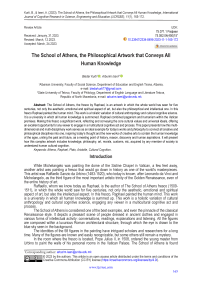The school of Athens, the philosophical artwork that conveys all human knowledge
Автор: Bledar Kurti, Arburim Iseni
Журнал: International Journal of Cognitive Research in Science, Engineering and Education @ijcrsee
Рубрика: Review articles
Статья в выпуске: 1 vol.11, 2023 года.
Бесплатный доступ
The School of Athens, the fresco by Raphael, is an artwork in which the whole world has seen for five centuries, not only the aesthetic, emotional and spiritual aspect of art, but also the philosophical and intellectual one. In this fresco Raphael painted the human mind. This work is a holistic variation of cultural anthropology and cultural cognitive science. It is a university in which all human knowledge is summoned. Raphael combined paganism and humanism within the Vatican premises. Making this fresco a significant work, reflecting and conveying the core cultural values and universal ideals, offering an excellent opportunity for any viewer to engage in a multicultural cognitive act and process. This paper presents how this multi-dimensional and multi-disciplinary work serves as an ideal example for today’s works and philosophy to connect all creative and philosophical disciplines into one, inspiring today’s thought and the new works of creative arts to contain the human knowledge of the ages, uniting the past and future, as a meeting point of history, reason, discovery and human aspirations. It will present how this complex artwork includes knowledge, philosophy, art, morals, customs, etc, acquired by any member of society to understand human cultural cognition.
Athens, raphael, plato, aristotle, cultural cognition
Короткий адрес: https://sciup.org/170198699
ID: 170198699 | DOI: 10.23947/2334-8496-2023-11-1-165-172
Список литературы The school of Athens, the philosophical artwork that conveys all human knowledge
- Augustine, St. (2015). City of God. Idaho: ROMAN ROADS ETEXT. Retrieved from https://files.romanroadsstatic.com/ materials/romans/nicene-christianity/City%20of%20God.pdf
- Berenson, B. (2005). Italian Painters of the Renaissance. USA: The Project Gutenberg eBook Retrieved from https://www. gutenberg.org/cache/epub/17408/pg17408-images.html
- Blunt, A. (1962). Artistic theory in Italy, 1450-1600 (Vol. 50). Oxford University Press on Demand.
- Bonacini, E. (2021). Digital storytelling nel marketing culturale e turistico. Palermo: D. Flaccovio.
- Bosman, P. R. (2014). The school of Athens: moments in the history of an idea. Akroterion, 59(1), 67-87. Retrieved from https:// hdl.handle.net/10520/EJC166906
- Cerella, A., & Bradley, A. (2023). Introduction: The Power of Representations: Towards a Semiotic Theory of the Imaginary. Political Theology, 24(1), 1-14. https://doi.org/10.1080/1462317X.2023.2166684
- Cocker, B. F. (2018). Christianity and Greek Philosophy. BoD–Books on Demand. Retrieved from https://www.gutenberg.org/ cache/epub/27571/pg27571-images.html
- Corrigan, J. (2017). How Do We Study Religion and Emotion? Feeling Religion Journal. Retrieved from https://www.dukeupress. edu/Assets/PubMaterials/978-0-8223-7037-6_601.pdf
- Crowe, J. A. & Cavalcaselle, G. B. (2022). Raphael: his life and works. With particular reference to recently discovered records, and an exhaustive study of extant drawings and pictures (Vol. 2). J. Murray.
- Ferah-Ozcan, A., & Yildiz, S. (2022). Direct and Indirect Effects Between First Literacy Errors, Visual Perception, and Phonological Awareness Variables. International Journal of Cogni-tive Research in Science, Engineering and Education (IJCRSEE), 10(3), 1–16. https://doi.org/10.23947/2334-8496-2022-10-3-1-16
- Forcellino, A. (2015). Raphael: A Passionate Life. Cambridge: Polity. Retrieved from https://www.academia.edu/11711976/_ Book_Review_Antonio_Forcellino_Raphael_A_Passionate_Life
- Green, V. H. H. (2000). A new history of Christianity. A&C Black. Retrieved from https://books.google.rs/books?hl=sr&lr=&id=U-N8lNI02R0C&oi=fnd&pg=PR7&dq=Green,+V.+(2000).+A+New+History+of+Christianity.+Leicester,+UK:+Continuum. +&ots=DsNo4BJGc0&sig=m3RFycOhKW-_5JvzxR5sDcLj2Ao&redir_esc=y#v=onepage&q&f=false
- Haas, R. (2012). Raphael’s School of Athens: A Theorem in a Painting?. Journal of Humanistic Mathematics, 2(2), 2-26. Retrieved from https://scholarship.claremont.edu/jhm/vol2/iss2/3/
- Joost-Gaugier, C. L. (1998). Ptolemy and Strabo and Their Conversation with Appelles and Proto-genes: Cosmography and Painting in Raphael’s School of Athens. Renaissance Quarterly, 51(3), 761-787. https://doi.org/10.2307/2901745
- Kissik, J. (1993). Art: Context and Criticism. Michigan, USA: Brown and Benchmark. Retrieved from https://books.google.al/ books/about/Art_Context_and_Criticism.html?id=CFMkAQAAMAAJ&redir_esc=y
- Kostov, B. (2013). On beauty and the beautiful in aesthetic education. International Journal of Cognitive Research in Science, Engineering and Education (IJCRSEE), 1(1), 71–75. Retrieved from https://www.ijcrsee.com/index.php/ijcrsee/article/ view/64
- Machiavelli, N, (1998). The Prince. USA: The Project Gutenberg eBook Retrieved from https://www.gutenberg.org/ files/1232/1232-h/1232-h.htm
- Moore, J. R. (2022). Art is Social Studies: Teaching the Renaissance Using Raphael’s School of Athens. The Social Studies, 113(4), 185-194. https://doi.org/10.1080/00377996.2022.2034729
- Schaeffer, F.A. (2022). How Should We Then Live? The Rise and Decline of Western Thought and Culture. Illinois, USA: Crossway. Retrieved from https://www.crossway.org/books/how-should-we-then-live-tpb-2/


